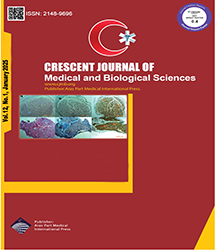
| Original Article | |
| The Association Between MTHFR C677T Polymorphism and Homocysteine Levels as Risk Factors for Coronary Artery Disease: A Case-Control study | |
| Saeideh Amani1, Ebrahim Mirzajani2,3, Seyed Mehrdad Kassaee1, Minoo Mahmoudi1, Fardin Mirbolouk4 | |
| 1Department of Biology, Hamedan Branch, Islamic Azad University, Hamedan, Iran 2Department of Biochemistry, School of Medicine, Guilan University of Medical Sciences, Rasht, Iran 3Cellular and Molecular Research Center, School of Medicine, Guilan University of Medical Sciences, Rasht, Iran 4Cardiovascular Diseases Research Center, Department of Cardiology, Heshmat Hospital, School of Medicine, Guilan University of Medical Sciences, Rasht, Iran |
|
|
CJMB 2025; 12: 054-060 DOI: 10.34172/cjmb.2023.3670 Viewed : 3584 times Downloaded : 5351 times. Keywords : Coronary artery disease, Homocysteine, Methylenetetrahydrofolate reductase (MTHFR), MTHFR C677T polymorphism |
|
| Full Text(PDF) | Related Articles | |
| Abstract | |
Objectives: Coronary artery disease (CAD) is the leading cause of disability and global death. Homocysteine is a major risk factor for CAD. High plasma homocysteine levels are an independent risk factor for this disease. Methylenetetrahydrofolate reductase (MTHFR) is one of the essential enzymes of homocysteine metabolism. In this way, mutations of genes encoding enzyme reduce its activity, which can increase blood homocysteine levels and ultimately raise the risk of CAD. Accordingly, this study aimed to investigate the association between MTHFR C677T polymorphism and homocysteine with CAD disease. Materials and Methods: The present investigation is a case-control study conducted on the patients of Heshmat hospital, Rasht, Iran. The demographic characteristics of 90 patients and 76 controls were obtained by questionnaires and blood samples were collected to evaluate homocysteine levels and gene polymorphism. MTHFR C677T polymorphism and blood homocysteine levels were assessed using amplification refractory mutation system polymerase chain reaction (ARMS-PCR) and ELISA, respectively, and a comparison was made between the two groups. The statistical analysis of the data was performed using SPSS software, version 21. Results: The frequency of C677T polymorphism genotypes in the control and patient groups was not statistically significant (P = 0.384). The highest frequency of genotype in the control (46.1%) and patient (50%) groups was shown in CT. Plasma homocysteine levels were significantly higher in CAD patients than in the control group (P = 0.001). Conclusion: The results of this study showed that the TT genotype of C677T polymorphism has a protective effect on CAD. Although the results obtained for C677T polymorphism are not statistically significant, this genotype had little effect on atherosclerosis. Consequently, the interaction of MTHFR gene polymorphism with CAD may be due to C677T genotype and homocysteine levels in the selected population of Guilan. |
Cite By, Google Scholar
Google Scholar
PubMed
Online Submission System
 CJMB ENDNOTE ® Style
CJMB ENDNOTE ® Style
 Tutorials
Tutorials
 Publication Charge
Medical and Biological Research Center
About Journal
Publication Charge
Medical and Biological Research Center
About Journal
Aras Part Medical International Press Editor-in-Chief
Arash Khaki
Deputy Editor
Zafer Akan


















